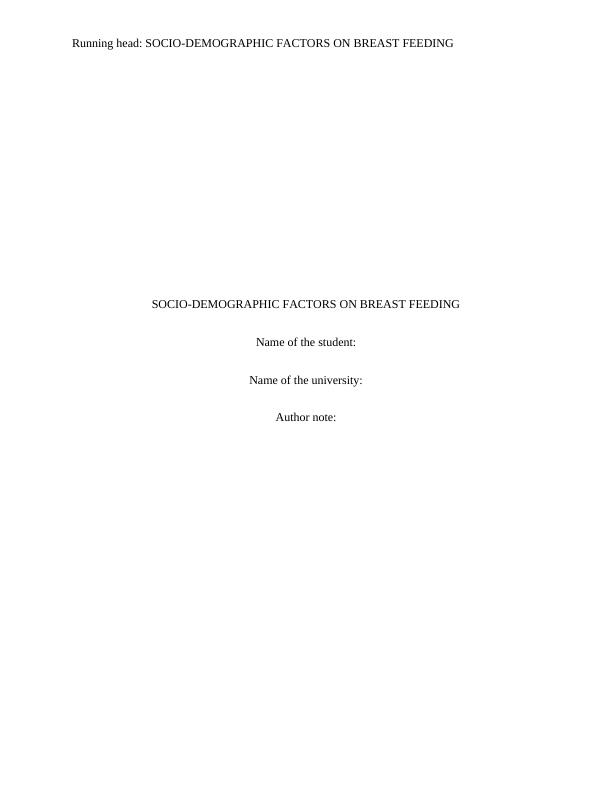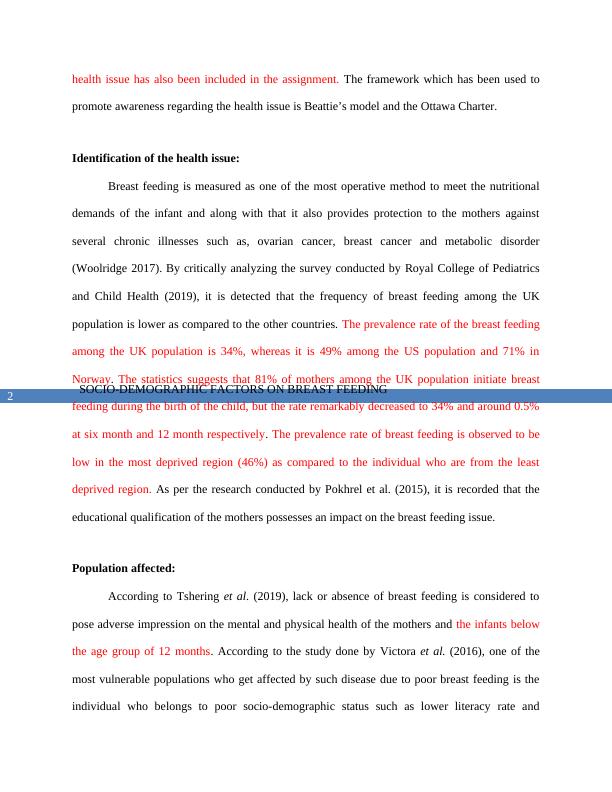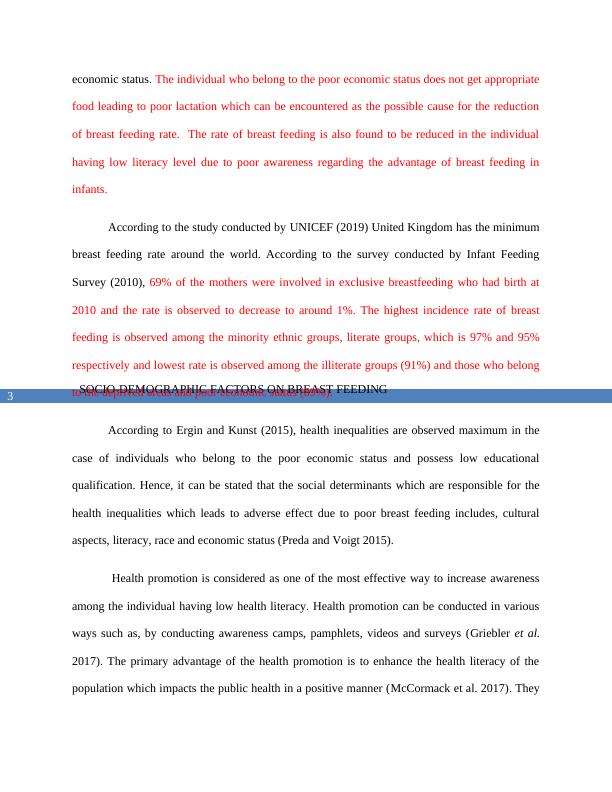Socio-Demographic Factors on Breast Feeding
Added on 2022-10-05
14 Pages3733 Words411 Views
Running head: SOCIO-DEMOGRAPHIC FACTORS ON BREAST FEEDING
SOCIO-DEMOGRAPHIC FACTORS ON BREAST FEEDING
Name of the student:
Name of the university:
Author note:
SOCIO-DEMOGRAPHIC FACTORS ON BREAST FEEDING
Name of the student:
Name of the university:
Author note:

SOCIO-DEMOGRAPHIC FACTORS ON BREAST FEEDING
1
Introduction:
According to World health organization (2019), breast feeding is considered as one of the
best way to feed the infants and to meet their nutritional demands. Poor breast feeding or lack of
breast feeding among the infants can lead to adverse health outcomes for the infants as well as
for the mothers (Victora et al. 2016). In the case of infants who are not breastfed appropriately
risk of obesity, leukemia, type 1 and type 2 diabetes and infant death syndrome (Simpson et al.
2019). It is due to the lack of essential nutrients which is required for the proper nutrition of the
infants that could only be provided from the mother’s milk and along with that breast milk also
produces anti-bodies which help the baby to fight from any infectious disease. In the case of the
mother, reduction in breastfeeding rate elevates the risk of chronic illness such as,
premenopausal breast cancer. Rendering to the research conducted by Vijayalakshmi, Susheela
and Mythili (2015), the socio-demographic factors of the mother is one of the major factors that
affects breast feeding among the infants. Socio-demographic factors in this context are referred
to as the educational achievement of the individual and the occupational status (Porta et al.
2016). The primary focus of the assignment is to understand the socio-demographic factors that
impact the breastfeeding among the individual. Infants below the age of 12 months are most
vulnerable to different chronic illness due to lack of fully developed immunity system, requires
breast milk to get the adequate amount of nutrition and anti-bodies and hence are included in the
research. Breast feeding rate in the individual who belongs to the poor economic status and low
literacy level are low due to poor lactation and poor knowledge regarding the advantage of breast
feeding and hence are selected as respondents. After that the health promotion strategy which aid
to promote effective approach to solve the health issue by educating the population about the
1
Introduction:
According to World health organization (2019), breast feeding is considered as one of the
best way to feed the infants and to meet their nutritional demands. Poor breast feeding or lack of
breast feeding among the infants can lead to adverse health outcomes for the infants as well as
for the mothers (Victora et al. 2016). In the case of infants who are not breastfed appropriately
risk of obesity, leukemia, type 1 and type 2 diabetes and infant death syndrome (Simpson et al.
2019). It is due to the lack of essential nutrients which is required for the proper nutrition of the
infants that could only be provided from the mother’s milk and along with that breast milk also
produces anti-bodies which help the baby to fight from any infectious disease. In the case of the
mother, reduction in breastfeeding rate elevates the risk of chronic illness such as,
premenopausal breast cancer. Rendering to the research conducted by Vijayalakshmi, Susheela
and Mythili (2015), the socio-demographic factors of the mother is one of the major factors that
affects breast feeding among the infants. Socio-demographic factors in this context are referred
to as the educational achievement of the individual and the occupational status (Porta et al.
2016). The primary focus of the assignment is to understand the socio-demographic factors that
impact the breastfeeding among the individual. Infants below the age of 12 months are most
vulnerable to different chronic illness due to lack of fully developed immunity system, requires
breast milk to get the adequate amount of nutrition and anti-bodies and hence are included in the
research. Breast feeding rate in the individual who belongs to the poor economic status and low
literacy level are low due to poor lactation and poor knowledge regarding the advantage of breast
feeding and hence are selected as respondents. After that the health promotion strategy which aid
to promote effective approach to solve the health issue by educating the population about the

SOCIO-DEMOGRAPHIC FACTORS ON BREAST FEEDING
2
health issue has also been included in the assignment. The framework which has been used to
promote awareness regarding the health issue is Beattie’s model and the Ottawa Charter.
Identification of the health issue:
Breast feeding is measured as one of the most operative method to meet the nutritional
demands of the infant and along with that it also provides protection to the mothers against
several chronic illnesses such as, ovarian cancer, breast cancer and metabolic disorder
(Woolridge 2017). By critically analyzing the survey conducted by Royal College of Pediatrics
and Child Health (2019), it is detected that the frequency of breast feeding among the UK
population is lower as compared to the other countries. The prevalence rate of the breast feeding
among the UK population is 34%, whereas it is 49% among the US population and 71% in
Norway. The statistics suggests that 81% of mothers among the UK population initiate breast
feeding during the birth of the child, but the rate remarkably decreased to 34% and around 0.5%
at six month and 12 month respectively. The prevalence rate of breast feeding is observed to be
low in the most deprived region (46%) as compared to the individual who are from the least
deprived region. As per the research conducted by Pokhrel et al. (2015), it is recorded that the
educational qualification of the mothers possesses an impact on the breast feeding issue.
Population affected:
According to Tshering et al. (2019), lack or absence of breast feeding is considered to
pose adverse impression on the mental and physical health of the mothers and the infants below
the age group of 12 months. According to the study done by Victora et al. (2016), one of the
most vulnerable populations who get affected by such disease due to poor breast feeding is the
individual who belongs to poor socio-demographic status such as lower literacy rate and
2
health issue has also been included in the assignment. The framework which has been used to
promote awareness regarding the health issue is Beattie’s model and the Ottawa Charter.
Identification of the health issue:
Breast feeding is measured as one of the most operative method to meet the nutritional
demands of the infant and along with that it also provides protection to the mothers against
several chronic illnesses such as, ovarian cancer, breast cancer and metabolic disorder
(Woolridge 2017). By critically analyzing the survey conducted by Royal College of Pediatrics
and Child Health (2019), it is detected that the frequency of breast feeding among the UK
population is lower as compared to the other countries. The prevalence rate of the breast feeding
among the UK population is 34%, whereas it is 49% among the US population and 71% in
Norway. The statistics suggests that 81% of mothers among the UK population initiate breast
feeding during the birth of the child, but the rate remarkably decreased to 34% and around 0.5%
at six month and 12 month respectively. The prevalence rate of breast feeding is observed to be
low in the most deprived region (46%) as compared to the individual who are from the least
deprived region. As per the research conducted by Pokhrel et al. (2015), it is recorded that the
educational qualification of the mothers possesses an impact on the breast feeding issue.
Population affected:
According to Tshering et al. (2019), lack or absence of breast feeding is considered to
pose adverse impression on the mental and physical health of the mothers and the infants below
the age group of 12 months. According to the study done by Victora et al. (2016), one of the
most vulnerable populations who get affected by such disease due to poor breast feeding is the
individual who belongs to poor socio-demographic status such as lower literacy rate and

SOCIO-DEMOGRAPHIC FACTORS ON BREAST FEEDING
3
economic status. The individual who belong to the poor economic status does not get appropriate
food leading to poor lactation which can be encountered as the possible cause for the reduction
of breast feeding rate. The rate of breast feeding is also found to be reduced in the individual
having low literacy level due to poor awareness regarding the advantage of breast feeding in
infants.
According to the study conducted by UNICEF (2019) United Kingdom has the minimum
breast feeding rate around the world. According to the survey conducted by Infant Feeding
Survey (2010), 69% of the mothers were involved in exclusive breastfeeding who had birth at
2010 and the rate is observed to decrease to around 1%. The highest incidence rate of breast
feeding is observed among the minority ethnic groups, literate groups, which is 97% and 95%
respectively and lowest rate is observed among the illiterate groups (91%) and those who belong
to the deprived areas and poor economic status (89%).
According to Ergin and Kunst (2015), health inequalities are observed maximum in the
case of individuals who belong to the poor economic status and possess low educational
qualification. Hence, it can be stated that the social determinants which are responsible for the
health inequalities which leads to adverse effect due to poor breast feeding includes, cultural
aspects, literacy, race and economic status (Preda and Voigt 2015).
Health promotion is considered as one of the most effective way to increase awareness
among the individual having low health literacy. Health promotion can be conducted in various
ways such as, by conducting awareness camps, pamphlets, videos and surveys (Griebler et al.
2017). The primary advantage of the health promotion is to enhance the health literacy of the
population which impacts the public health in a positive manner (McCormack et al. 2017). They
3
economic status. The individual who belong to the poor economic status does not get appropriate
food leading to poor lactation which can be encountered as the possible cause for the reduction
of breast feeding rate. The rate of breast feeding is also found to be reduced in the individual
having low literacy level due to poor awareness regarding the advantage of breast feeding in
infants.
According to the study conducted by UNICEF (2019) United Kingdom has the minimum
breast feeding rate around the world. According to the survey conducted by Infant Feeding
Survey (2010), 69% of the mothers were involved in exclusive breastfeeding who had birth at
2010 and the rate is observed to decrease to around 1%. The highest incidence rate of breast
feeding is observed among the minority ethnic groups, literate groups, which is 97% and 95%
respectively and lowest rate is observed among the illiterate groups (91%) and those who belong
to the deprived areas and poor economic status (89%).
According to Ergin and Kunst (2015), health inequalities are observed maximum in the
case of individuals who belong to the poor economic status and possess low educational
qualification. Hence, it can be stated that the social determinants which are responsible for the
health inequalities which leads to adverse effect due to poor breast feeding includes, cultural
aspects, literacy, race and economic status (Preda and Voigt 2015).
Health promotion is considered as one of the most effective way to increase awareness
among the individual having low health literacy. Health promotion can be conducted in various
ways such as, by conducting awareness camps, pamphlets, videos and surveys (Griebler et al.
2017). The primary advantage of the health promotion is to enhance the health literacy of the
population which impacts the public health in a positive manner (McCormack et al. 2017). They

End of preview
Want to access all the pages? Upload your documents or become a member.
Related Documents
The Role of Social Support in Breastfeedinglg...
|19
|4901
|65
Policy Analysis - Assignment PDFlg...
|18
|4544
|89
Health Advancement and Promotion Assignment | Breastfeeding Reportlg...
|9
|2365
|64
Knowledge, Attitude and Practices on Exclusive Breastfeeding in Lactating Mothers of Infants Aged 0-6 Months in Addu Citylg...
|15
|5502
|444
Nursing Assignment on Breastfeedinglg...
|7
|1712
|1441
Policy, Power and Politics in Healthcarelg...
|14
|3898
|498